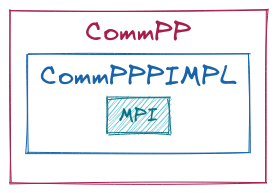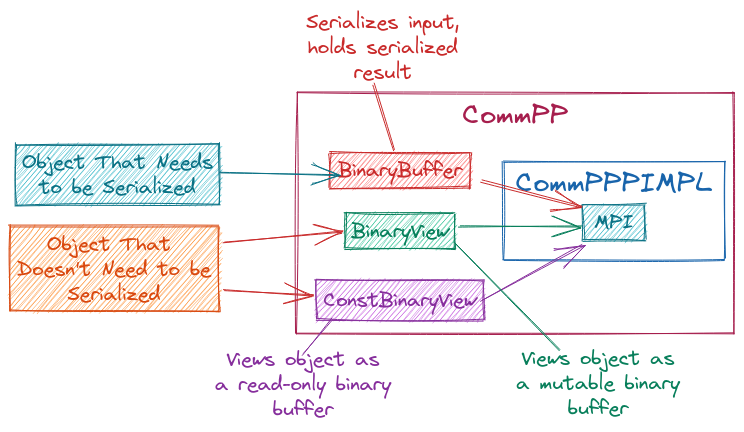Designing CommPP Class
The design specifications in Designing RuntimeView Class and Designing RAM Class
call for a CommPP class to take care of the MPI operations. Here we
discuss the design of the CommPP class.
Why Do We Need CommPP?
ParallelZone needs access to MPI. ParallelZone is object-oriented and needs something to bridge the gap between objects and types recognized by MPI. At a high-level this leads to serialization, but naive application of serializaiton in an MPI context can lead to inefficiencies. CommPP should automate the conversion from objects to MPI data types in the most efficient manner possible.
Design Considerations
The list below includes considerations from Designing RuntimeView Class and from Designing RAM Class.
Support for all-to-all, all-to-one, and one-to-all MPI operations
Provide parallel primitives for building up more sophisticated infrastructure
SIMD API
Heavy use of template meta-programming to simplify API
Generic objects will need to be serialized.
CommPP Architecture

Fig. 10 Overall architecture of the CommPP class.
Conceptually the state of the CommPP class is simple. The only point of note
is that we use the PIMPL idiom to hide the MPI-based implementation from the
API. The tricky part of the CommPP class will be the conversion of objects
into a format suitable for consumption by MPI. Presently we adopt the lowest
common denominator, and transform all objects to binary.

Fig. 11 Schematic illustration of how CommPP converts an object into a binary format.
Fig. 11 sketches out the object-to-binary process. On the left
we see two input scenarios depending on whether the object the user provided
needs serialized or not. If the object needs serialized CommPP uses the
object to initialize a BinaryBuffer object. If the object does not need
serialized CommPP initializes a BinaryView or a ConstBinaryView
instance depending on whether we need to mutate the object or not respectively.
CommPP then uses the BinaryBuffer, BinaryView, or
ConstBinaryView object to interact with MPI.
This design addresses the above concerns by:
Exposing the stated MPI operations in an object-oriented manner.
Not explicitly shown in the above architecture diagrams, but the APIs of the
CommPPclass are envisioned as having a number of overloads for a variety of scenarios. Choosing the optimal overload is a somewhat technical detail, which is whyCommPPis thought of as an implementation detail.Proposed APIs are covered in Designing RuntimeView Class and Designing RAM Class
Not explicitly shown, but it is expected that
CommPPwill use template- meta programming to deduce whether to convert an object into aBinaryBuffer,BinaryView, orConstBinaryView.Serialization happens under the hood and is the responsibility of the
BinaryBufferclass.